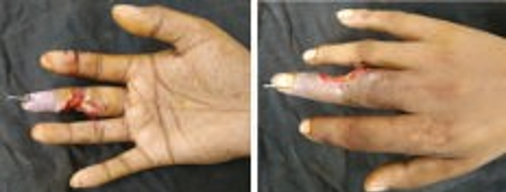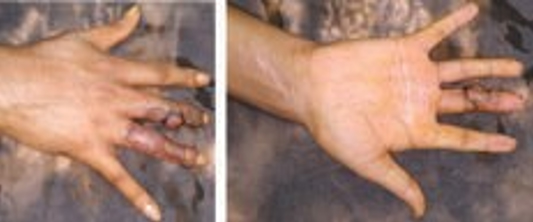Avijit Sarker
Department of Burn & Plastic surgery, National Institute of Traumatology & Orthopedic Rehabilitation (NITOR), Dhaka, Bangladesh.
Monsur Rahman Choudhury
Sheikh Hasina National Institute of Burn & Plastic Surgery (SHNIBPS), Dhaka, Bangladesh.
Keywords: Revascularisation, warm ischaemia time, interposition vein graft, Quality-of-life.
DOI: 10.3329/bmrcb.v47i3.59248
Abstract
Background: Amputation of fingers is not a life-threatening event but can lead to a decrease in quality-of-life. Revascularisation is the treatment of choice for near total amputated fingers, can be a treatment of choice toward improved functional and aesthetic advantages.
Objective: To assess the revascularisation status following near total amputation of a finger.
The Case: A case of near total amputation of right middle finger through middle phalanx and its salvage by revascularisation of ulnar side digital artery by interposition vein graft after 15 hours of warm ischaemia time.
Conclusion: Revascularisation of finger is possible even in greater ischaemic time which is the result of improved skill and modern microsurgical instruments.
Keywords: Revascularisation, warm ischaemia time, interposition vein graft, Quality-of-life.
Introduction
Amputation of fingers is not a life-threatening injury but it causes functional and psychological problems which ultimately lead to decrease in quality-of-life. Despite microsurgical and technical advances, it is still difficult to achieve satisfactory functional results in cases of re-plantation or revascularization.1
There are numerous factors to be considered in replantation or revascularisation surgery. It includes the actual tissues to be replanted, the patient’s general medical condition and less obvious factors are the social, economical and psychological aspects.2 Despite numerous steps and procedures, revascularisation remain the prime indication for treatment of near total amputated fingers, due to functional and aesthetic advantages.
The Case
A 29 year old man sustained injury to his right middle finger on 13th May 2019 at around 2 PM while traveling by an autorickshaw. He attended to the emergency department of nearby hospital. His right middle finger was amputated through the middle phalanx and only attached with a dorsal skin tag. After thorough debridement, stabilisation of the fracture was done by an axial k wire and skin suturing done loosely with 3-0 prolene. He was treated as an OPD case with advice to attend if any colour change of the finger is observed. Eight hours after the initial injury, he observed some change in colour of the finger . It was after fourteen hours of initial injury when we examined the patient in plastic surgery unit of City Hospital Ltd. The finger was dusky and cold. No waveform observed in pulse oximetry test of the finger. He was explained about the possible outcome considering the ischaemia time and condition of the injured finger (Figure 1). Arrange for revascularisation was made and informed written consent was taken. The right upper limb was anaesthetised by brachial plexus block and a pneumatic tourniquet was applied. The finger was washed with sterile saline and wound debridement was done, and Kirschner wire was kept unaltered. Both the digital artery were crushed with segmental loss. Digital nerve on radial side was transected. Planning was made to revascularise the finger by anastomosing the ulnar side digital artery with reversed vein graft. (Figure 2). Vein for graft harvested from distal forearm and anastomosis completed with 10-0 nylon under microscope. After releasing the clamp the fingertip became pink. Radial side digital nerve was coapted with 10-0 nylon. Skin closed with 5-0 prolene. Pouring of warm saline was done for 20 minutes on the fingertip and good capillary refill was observed. Long arm posterior cast applied and limb kept elevated. (Figure 3).
Postoperatively, the tip of the finger was monitored every 2 hourly for first 24 hours and then 4 hourly up to 5th postoperative day. Adequate hydration, limb elevation maintained. Heparin drip continued for 5 days. First dressing changed on 8th postoperative day. Patient was discharged on 10th postoperative day with advice for follow up after one week. Subsequent follow up revealed that the finger survived well with small area skin loss on ulnar aspect of that finger at the primary injury site. Plan was made to cover the wound by cross finger flap from adjoining ring finger. Donor area of ring finger was skin grafted. Flap survived well with good graft take. After complete wound healing he was encouraged to do gradual hand physiotherapy (Figure 4).
Discussion
Proper preservation of amputated part during transfer is an integral part for successful outcome in total amputation of finger. But in near total amputation, the nearly amputated segment is preserved less commonly due to technical difficulty. Cases where the digit or limb is hanging by a skin tag should still be preserved by wrapping it in a saline-moistened gauze. A plastic bag sealed with ice in it should be placed adjacent to the digit or limb and then the whole area bandaged to keep the ice in place.3
A revascularisation seems to be an easier operation than replantation; but practically it is often more difficult. In incomplete amputations, significant shortening of bone is not always possible. So, the surgeon need to use vein grafts, nerve grafts, or skin flaps more frequently to bridge any defects.2
For a successful revascularisation it is important to anastomose vessels well away from zone of injury, and for this reason, most of the time vein graft needed to bridge the gap between vessel ends. It is preferable to do vascular anastomosis under microscope. Intra- operatively, vessel irrigation is done with heparin solution (100 units per cc of saline) before anastomosis. Lidocaine (1%) used empirically to treat intra-operative vascular spasm.4
Early recognition of vascular compromise (arterial insufficiency or occlusion and venous occlusion) is key for salvage of failing replant. A pale or dusky finger points to arterial occlusion. Adequate hydration, prescribing anticoagulants to the patient, are essential preventive measures. In case of venous obstruction, the finger becomes swollen, turns blue or purple and looks congested. Venous obstruction is more detrimental compared to arterial occlusion due to toxin accumulation and breakdown of metabolites.3 Limb elevations, measures to keep the operative site warm are essential post operative measures. At one week post-revascularisation there is less chance of ischaemic necrosis. Thus, it was prefered to change dressing from 8th POD onwards.
Generally, if the warm ischaemic time is greater than 6 hours for an amputation proximal to the carpus or 12 hours for the digits, replantation/revascularisation is not usually recommended. Replantation is not generally performed if the cold ischaemic time is greater than 12 hours for a proximal amputation. Because it has no muscle, an amputated digit may be preserved at 4°C for 24 hours before replantation is performed. This usually applies only to digital amputations in which preservation of muscle tissue is not necessary.5
Conclusion
The patient and family desire replantation/ revascularisation and expect a miraculous result. The surgeon should explain to the patient, the chances of success of viability, anticipated function and time lost from work during rehabilitation. With the advent of modern microsurgical instruments and improved microsurgical skill better results can be obtained in replantation/revascularisation of amputated fingers.
References
- Armen K.K. and Nolan S.K.: Lower extremity reconstruction. Grabb and Smith’s plastic surgery, Lippincott- Wilkins, 7 ed. 2014. p. 941-954. ISBN-13: 978-1451109559
- Harry J. Buncke : Microsurgery: Transplantation-Replantation An atlas-text, Lea & Febiger,4 ed. 1991. p. 550-552. ISBN-13: 978-0812109818
- Marco Maricevich & Brian Carlsen & Samir Mardini & Steven Moran. Upper extremity and digital replantation. HAND. 2011; 6:356–363.
DOI: 10.1007/s11552-011-9353-5 - Enrique Fossati, M.D., and Alberto lrigaray, M.D., Montevideo, Uruguay . Successful revascularization of an incompletely amputated finger with serious venous congestion- A case report. The Journal of Hand Surgery. 1983; 8: 356-58.
DOI: 10.1016/S0363-5023(83)80183-X - Duffy, F.J., Concannon, M.J., Gan, B.S., May J.W. Late digital replantation failure: pathophysiology and risk factors. Ann Plast Surg. 1998; 40: 538-41.
DOI: 10.1097/00000637-199805000-00018
National Institute of Trauma- tology & Orthopedic Rehabilitation (NITOR), Sher-E-Bangla Nagar, Dhaka, Bangladesh.
ripondmc@gmail.com
 0000-0001-6037-3595
0000-0001-6037-3595
Submission
13 January 2021
Accepted
11 November 2021
Published
01 December 2021
Apply citation style format of Bangladesh Medical Research Council
Issue
Vol 47 No 3 (2021)
Section
Case Report
Financial Support
None
Conflict of Interest
None



